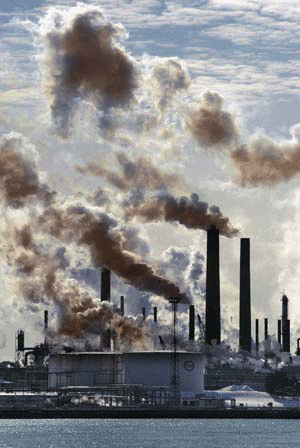Shocking Levels of Air Pollution in Northeast China
October 22, 2013
Air pollution in the northeast Chinese city of Harbin was literally off the chart yesterday, forcing the closure of schools, paralyzing traffic, and shutting down the airport. In parts of the city, visibility was near zero. “You can’t see your own fingers in front of you,” declared the city’s official news site.

Coal-burning plants and factories, which are common in China, produce sulfur dioxide, an air pollutant that causes acid rain and produces dangerous particulate matter in the atmosphere (© age fotostock/SuperStock).
The Harbin government reported an air quality index (AQI) score of “above 500″; 500 is the upper limit on scales used by both the Chinese government and the U.S. Environmental Protection Agency (EPA). By comparison, the AQI score in New York City yesterday was 41. The EPA labels any reading between 301 and 500 as “hazardous.” The standards set by the World Health Organization characterizes a score above 500 to be more than 20 times the level of particulate matter in the air deemed safe.
The China News service reported that yesterday’s PM2.5 (particulate matter with a diameter of 2.5 micrometers) measurement in Harbin topped 1,000 micrograms per cubic meter. This surpassed the peak of 900 in Beijing in January in what became known as that city’s “air-pocalypse.” Health experts note that particles at a level of PM2.5 are particularly dangerous because the matter is small enough to penetrate deep into the lungs and enter the bloodstream.
The Harbin weather bureau blamed the pollution on a lack of wind; local farmers burning corn stalks after the harvest; vehicular emissions; and the firing up of the municipal central heating system—coal-burning boilers that provide hot-water heat to the entire city of 3.5 million. China remains heavily dependent on coal. Fully 68.4 percent of China’s energy usage is from coal, much of it high sulfur-content coal. When coal is burned, its sulfur content combines with oxygen to form sulfur dioxides. Sulfur dioxide is a pollutant gas that contributes to the production of acid rain and causes significant health problems, particularly through its role in forming particulates.
Additional World Book articles:
- The Case for Renewables (a special report)
- China 2012 (a Back in Time article)


